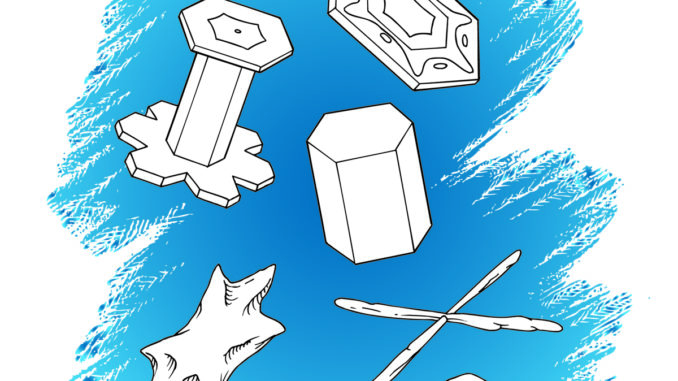
Bio Bites
By R. Gary Raham
A biologist-artist’s ruminations about our roles in a science-inspired world
Snowflakes can be fun, especially if you don’t need to drive through a bazillion of them all at once. Looked at individually, snowflakes can provide hours of admiration and entertainment. It’s possible to capture the lacy, six-armed stars and other forms that snow can take and even preserve them to look at next July.
Collecting Snowflakes
Begin with a piece of black velvet or black cardboard to serve as a flake collector. Go out on a calm, snowy day and place the collector on a flat surface. Observe the flakes as they crash and tumble onto the dark background. Get close enough to see the forms of the snowflakes. Avoid melting them with a hot breath of admiration. If you have a magnifying glass, use it to take an even closer look.
Notice that some snowflakes look like stars. Others look like needles, prisms, and six-sided plates. Sometimes you will find mixtures of these basic forms or irregular lumps called graupel. If graupel bangs together enough in clouds and collects more moisture it turns into ice pellets and hail.
Endless Variety
The exact form that crystalizing water takes depends on temperature and humidity. Scientists have described ten basic forms from classic snowflakes to hail, but don’t worry about getting bored. Each kind has endless variations.
The combination of temperature, moisture, and air circulation that flips crystals up and around a cloud before they get heavy enough to fall is so complex that most likely each snowflake is unique–like you. This is a little hard to verify, though, because scientists estimate that it takes 18 million snowflakes to make just one cubic foot of snow. Thus, in the 600 cubic miles of snow that cover the Northern Hemisphere of the Earth at any given time, there are more snowflakes than there are stars in our galaxy! No one has seen more than a tiny fraction of these ice flakes.
Preserving Snowflakes
Over a hundred years ago, in the late 1880’s, Wilson “Snowflake” Bentley spent many happy Vermont winters collecting and photographing snowflakes with his camera. In 1931 he published a book called Snow Crystals that showed the beauty and variety of some of the most perfect crystals he could find. But there is another way to preserve snowflakes for admiring at a later time. Here is what you will need:
- Glass slides or small pieces of picture glass
- Acrylic spray from a hobby or art store.
- A cold, sheltered place outdoors, like a shed–someplace where drafts won’t blow the snowflakes around.
In the 1940s, Vincent J. Schaefer made tiny plastic replicas of snowflakes. Here’s how to make your own, using a variation of his technique:
Spray a glass slide with acrylic. (CAUTION: Spray the slides someplace with good air circulation and don’t breathe the vapors.) Set the slide outside for a few minutes to collect several snowflakes. Move the slide to your “cold room” (shed) and let it sit undisturbed for a couple of hours. The acrylic will evaporate and re-condense around the snowflake, making a tiny mold that you can later examine with a magnifier or microscope.
So don’t slip on, shovel, throw, build with, ski down, plow, pack–or eat–all the snow you find. Save a few flakes to look at, admire, and cherish some hot summer afternoon when last winter’s snow seems worth revisiting.
Support Northern Colorado Journalism
Show your support for North Forty News by helping us produce more content. It's a kind and simple gesture that will help us continue to bring more content to you.
BONUS - Donors get a link in their receipt to sign up for our once-per-week instant text messaging alert. Get your e-copy of North Forty News the moment it is released!
Click to Donate
